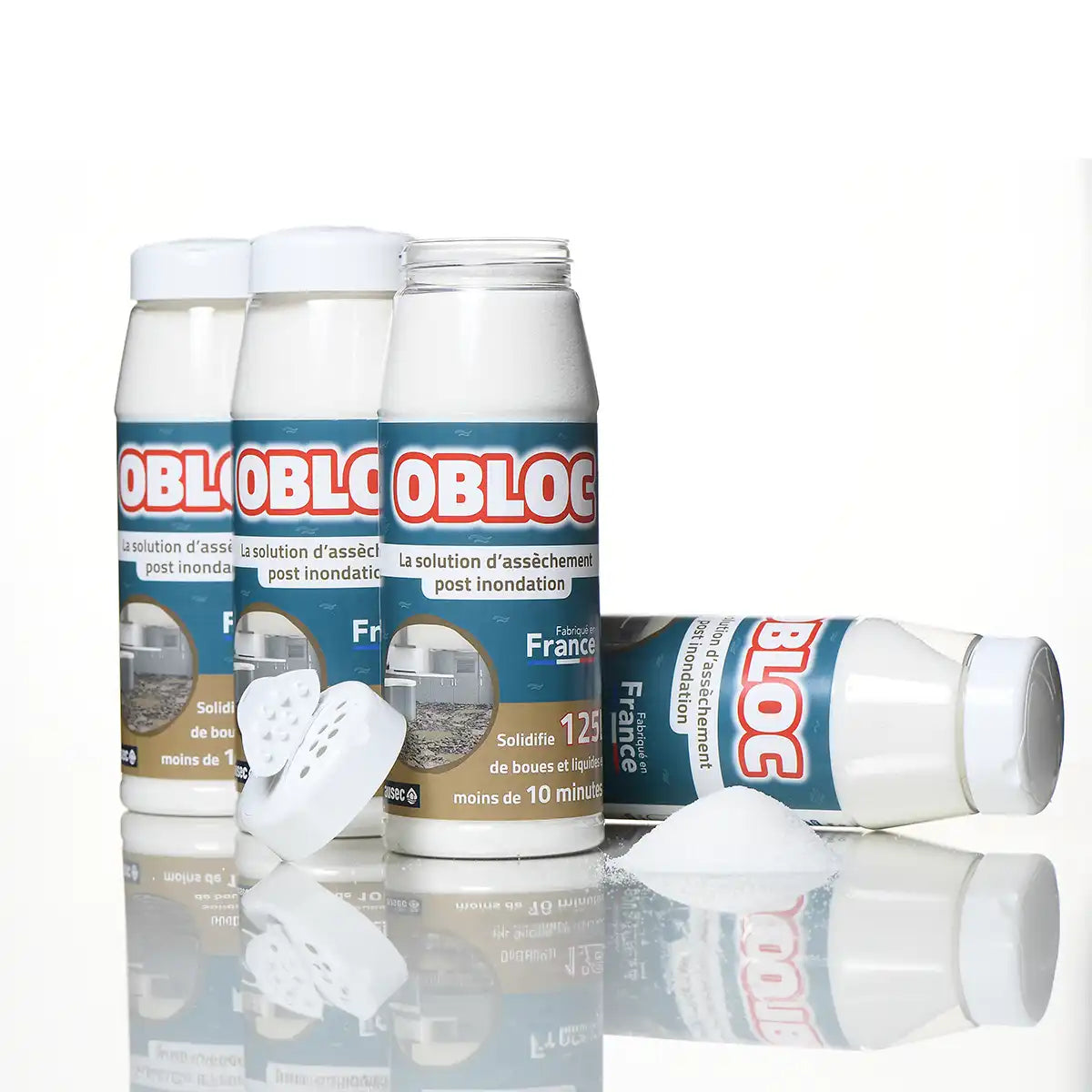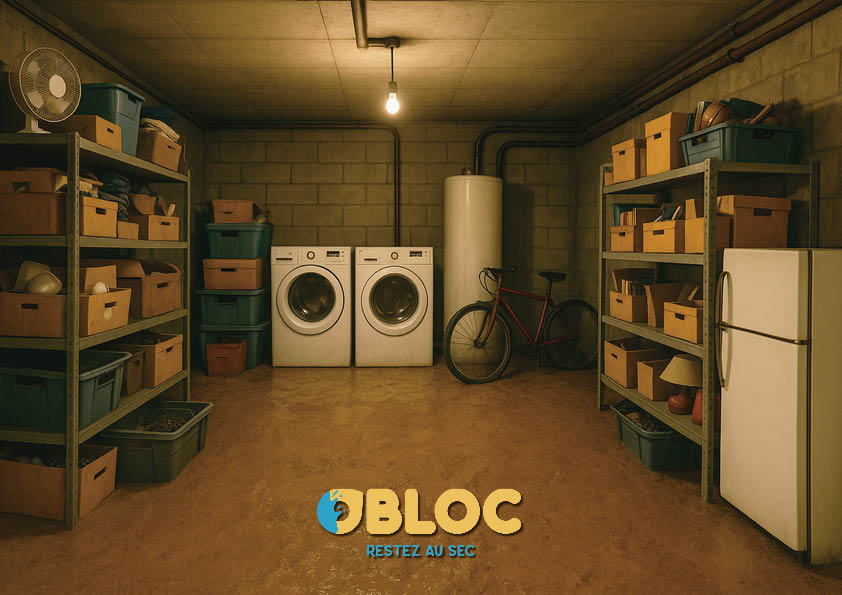When a basement fills with water, the consequences can be more serious than you might imagine. Whether it's a simple leak or a completely submerged basement, property damage, mold, or even lost equipment are common. These situations, often triggered by heavy rain, a rising water table, or a drainage system failure, leave residents disoriented. At OBLOC®, we know how stressful this type of episode can be. That's why we've written this article to guide you through each step: understanding, acting, preventing, and knowing who to call.
Why is my basement flooding?
Understanding the cause of the flood
Water infiltration into a cellar can result from several factors. The most common: a sudden rise in the water table, generally after a Cévennes episode or prolonged heavy rain. The water, pushed by ground pressure, seeps into the cellar walls, often through cracks or weak points in the waterproofing. This is called rising damp.
Another common cause is a faulty or non-existent drainage system. Rainwater is not efficiently redirected and accumulates at the base of walls, infiltrating the foundations through joints or old drainage columns. This can be exacerbated if your land is classified as a flood-prone area, as in Vernoux-en-Gâtine or other vulnerable communities.
Finally, poorly executed work or a lack of regular pipe maintenance can also lead to water infiltration. The proximity of a shared wall, a cracked drainpipe, or an improperly sloped floor can create entry points for moisture. In all cases, it is crucial to accurately identify the cause of the flooding in order to adapt solutions.
Is it serious if a basement floods?
Consequences for the building and occupants
A flooded basement is never a trivial problem. It compromises the building's structure, including the basement walls, foundations, and technical equipment such as the gas boiler or electrical system. Even low water levels can lead to mold growth, with a direct impact on the health of the occupants.
Persistent humidity in a basement creates an environment conducive to respiratory problems, unpleasant odors, and even serious consequences for stored goods. When faced with a regularly flooded basement, the situation becomes critical if signs of concrete deterioration or water infiltration reach the ground floor.
How to dry out a cellar after a flood?
Key steps to manage water and prevent mold
Draining begins with draining the water. If the flooding is significant, it is essential to use a lifting or pumping pump. In the absence of electricity, manual solutions exist: sump with gravity drainage, buckets, or absorbent mats .
Once the water has drained, drying the basement is essential. Opening windows (if available), installing ventilation grilles, or using a dehumidifier will help promote air circulation. The walls and floor should be monitored for several days to prevent rising damp. It is also recommended to remove damaged items and clean quickly to prevent mold growth.
Who to call in case of a flooded cellar?
Call an expert or take steps with the insurance company
As soon as water appears, it is recommended that you contact your insurer to report the damage. Some insurance companies require specific evidence: photos, videos, humidity readings, and repair invoices. If the flooding is linked to a natural disaster, a prefectural decree will allow you to activate the associated coverage. This is the case in many municipalities located in flood-prone areas or exposed to extreme weather events.
At the same time, a professional can diagnose the cause of the damage (blocked drainpipe, cracks, drainage system in need of repair, etc.). Depending on the situation, it may be appropriate to call on an independent expert, especially if you are in a co-ownership or if hidden defects are suspected. The case law is clear: the builder or seller can be held liable in the event of an unreported waterproofing defect.
How to empty a flooded cellar without a pump?
In some cases, you don't have access to a sump pump. In this case, there are several alternatives. You can create a ground sump, install a temporary sloping pipe to promote drainage, or use absorbent powders in addition to manual wiping. These techniques are not a substitute for professional equipment, but they can help limit damage in an emergency.
Next, you need to ensure proper ventilation in the cellar. This involves opening access points, temporarily installing fans, or using natural moisture absorbers. A crawl space or an underground room without ventilation is particularly vulnerable to waterlogging and the growth of fungi.
How to clean a flooded basement?
After pumping, cleaning is crucial
Once the cellar is emptied, a thorough cleaning is essential. Start by disinfecting all surfaces with products suitable for humidity. The cellar walls should be dry-brushed, then washed. Check that the power supply and appliances (freezer, hot water tank, gas boiler) have not been affected. If in doubt, do not turn them back on without professional approval.
Also consider inspecting structural elements: the building's structure, the floor, the joints, and the waterproofing of the walls. If you are a tenant, inform the landlord or the property manager promptly and build a solid case to assert your rights.
What solutions are there to prevent future floods?
Prevention is, above all, about being equipped. A flood alarm can detect water from the first few centimeters. Flood protection tubes , easy to store, can be installed quickly in the event of a threat. But that's not all.
Installing an efficient drainage system, inspecting downspouts, and maintaining drainpipes are all actions that should be carried out regularly. It is also advisable to check that the cellar complies with ventilation and waterproofing standards.
Protecting your home means acting now
Whether you're a homeowner, renter, or a condominium owner, a flood can strike without warning. Heavy rain, water infiltration, an underground system... every detail counts. By understanding the causes, acting quickly, and surrounding yourself with the right solutions, you can transform a critical event into a manageable situation.





Leave a comment
This site is protected by hCaptcha and the hCaptcha Privacy Policy and Terms of Service apply.